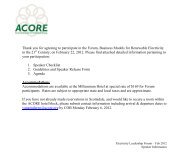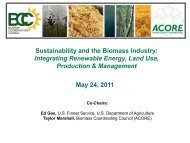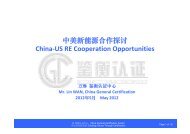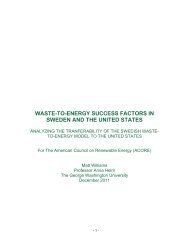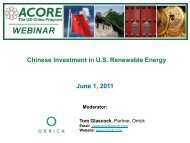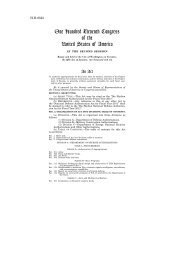Read More - American Council On Renewable Energy
Read More - American Council On Renewable Energy
Read More - American Council On Renewable Energy
You also want an ePaper? Increase the reach of your titles
YUMPU automatically turns print PDFs into web optimized ePapers that Google loves.
Wind: Markets, Technologies, and PolicyOverviewWind energy currently makes up most of therenewable power capacity in the United States(excluding large hydroelectric projects), with over25 GW of wind power capacity as of 2008. Theamount of wind energy will continue to increasenationwide as engineering improvements drivedown the cost of turbines, making electricity fromwind cost-effective with traditional forms of powergeneration. The market for wind power is,however, still sensitive to policy and incentivechanges, so it is important to assess the factorsthat affect the wind energy industry. The windenergy sessions at RETECH covered issues relatedto wind turbine technology, the current status ofwind markets, and the related policy environment.ConsensusMost of the speakers envisioned a future in whichwind power will make up about 20% of thenation’s electricity by 2030. This future willnecessitate increases in turbine size,improvements in offshore wind technology, and avast expansion of the nation’s transmissionsystem. Cost will continue to decrease as themarket grows and technologies improve.Additionally, the market for small windapplications will grow, due to the advantagesassociated with distributed generation, and thebenefits of local ownership. However, most of thespeakers predicted a significant decrease in windturbine installations in 2009 (compared to 2008),but expect the market to rebound in 2010 as aresult of the stimulus package and othersupportive policies. The Investment Tax Credit forwind was predicted to be an important incentivefor developers, and the option for cash grants willenable more developers to reap the benefits ofthe tax credit.Wind TechnologyEngineering improvements will continue toincrease the efficiency of utility-scaleturbines, allowing turbines to produce moreenergy per hour.Turbine improvements include taller towers,larger rotors on smaller generators,improved grid support, and slower turninggenerators. Turbine size will continue toincrease to about 5 MW for land-based turbinesand up to 10 MW for offshore turbines.<strong>More</strong> wind projects will be located offshore inthe future.The market for offshore wind power will be driven bytechnology improvements that allow turbines to be locatedfarther from the shore in deeper water, as well as engineeringimprovements that create turbines with muchlarger capacity.Demand for small-scale wind applications willalso increase.Not only will utility-scale wind turbines continue to improveand become more efficient, but small-scale residentialand community based turbines will benefit from engineeringenhancements as well. Because small-wind applicationsdo not face many of the constraints of large-scalewind projects—notably transmission access—the marketfor these projects will continue to grow. Small windsystems may be grid-tied or off-grid, and can also be usedwith battery storage systems to open new markets andmake systems more useful. Additionally, small windsystems may be used jointly with solar PV systems.Small wind allows customers to put thepower where they want it.– Mike Hess, CEO, Mariah PowerDespite the positive outlook for the windindustry, barriers to wind energy deploymentremain.<strong>American</strong> <strong>Council</strong> <strong>On</strong> <strong>Renewable</strong> <strong>Energy</strong>Executive Summary Report 63






